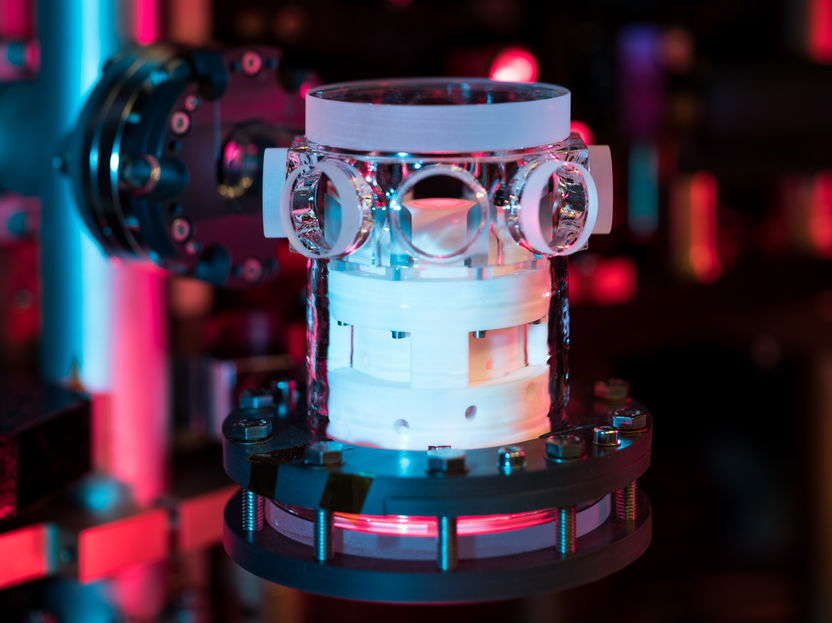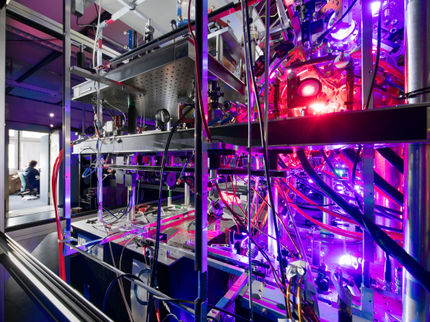Deep look into the dipolar quantum world
An ultra-accurate quantum gas microscope for observing magnetic quantum matter
Advertisement
Two world-leading research groups, one led by Francesca Ferlaino and the other led by Markus Greiner, have combined their expertise to develop an ultra-precise quantum gas microscope for observing magnetic quantum matter. This can be used to observe complex, dipolar quantum states that are the result of particle interactions, the scientists report.

The quantum gas microscope resembles a ship in glass: the vacuum chamber and lens are located in a glass cell, and lasers are used to create a light crystal in the chamber.
M.R.Knabl
Magnetic atoms are at the heart of Francesca Ferlaino's research on quantum matter. The particles have unparalleled properties for quantum experiments. At the Institute of Quantum Optics and Quantum Information (IQOQI) of the Austrian Academy of Sciences and the Institute of Experimental Physics at the University of Innsbruck, the experimental physicist and her team are investigating states of matter that could not be studied before. In 2012, for example, they realized the first Bose-Einstein condensate of erbium, and in 2019 they became one of three teams to observe suprasolid states in ultracold quantum gases of magnetic atoms for the first time. The team, led by German-born physicist Markus Greiner, is pioneering the development of optical techniques for direct observation of individual atoms. At Harvard University, the physicists have used high-resolution microscopy to visualize many exotic phenomena in strongly correlated ultracold quantum gases, such as anti-ferromagnetic phases in 2017.
A few years ago, Ferlaino and Greiner decided to combine their expertise and jointly build a quantum gas microscope for magnetic atoms, with the goal of making new phenomena accessible. "Due to their strongly magnetic character, the particles influence each other over much larger distances than non-magnetic particles and their influence always acts in a specific direction," Francesca Ferlaino explains. "Due to the properties of the particles, we can observe interactions in these quantum gases that cannot be seen in conventional experiments. This offers us completely new insights into how solids work."
New quantum solids observed
The research teams worked together for years to develop the new experiment and set up two microscopes in Austria and the United States. "We manufactured parts of the apparatus here in Innsbruck," Ferlaino says. Today, both Harvard and Innsbruck have a quantum gas microscope for dipolar quantum gases. It uses laser beams to create a light grid in which erbium atoms cooled to extremely low temperatures are distributed. Magnetic fields can be used to align the particles differently and thus control the interactions. The lens of the microscope is located inside a glass vacuum cell, and the setup is thus reminiscent of a ship in a bottle.
Markus Greiner's group now presents the first results of this work in the journal Nature. The scientists have succeeded in showing how different dipolar quantum solids can be generated from superfluid phases by manipulating the interactions in the apparatus. These show up in the microscope as different patterns: transverse stripes, checkerboard patterns or diagonal stripes. "Here, the long-range, directed interaction of the particles determines the properties of the matter cloud, and the ordering force of the light crystal is refracted," explains Francesca Ferlaino.
The basis for this breakthrough was many years of close collaboration between two experimental research groups across an ocean. The joint work now enables simulations of quantum systems with long-range and directional interactions, creating the basis for new insights into the properties of quantum matter. "This is interesting for all phenomena dominated by these interactions, such as ferromagnetism," Ferlaino enthuses.
Note: This article has been translated using a computer system without human intervention. LUMITOS offers these automatic translations to present a wider range of current news. Since this article has been translated with automatic translation, it is possible that it contains errors in vocabulary, syntax or grammar. The original article in German can be found here.





























































